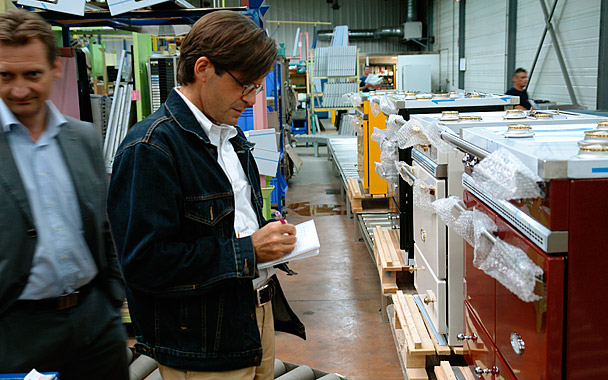I’ve rented apartments for most of my adult life, cooking on whatever sorry-looking appliance came with the lease. Last year, though, my partner and I bought a place in New York City and during the course of our kitchen renovation we purchased a Lacanche, the classic French stove. Intrigued by my pre-purchase research, I decided to make a pilgrimage to Burgundy, where the tiny town of Lacanche has been associated with France’s steel industry since the 17th century. While it’s said that bullets were made here for Napoleon, more peaceable types of manufacturing eventually prevailed, with cast iron cookers and heaters being fabricated locally since the mid-18th century. Today, nearly 200 of this remote village’s approximately 700 residents work at the Lacanche factory.
Upon my arrival, I was met by Jean-Jacques Augagneur, the General Manager of Lacanche, who was dazzlingly courteous and something of a philosopher. A discussion of how wine casks are constructed, for instance, led him into a fascinating discourse on naval architecture. Over lunch at a small café—rabbit, braised in a mustard sauce—Augagneur gave me a quick history of the stove: For centuries, cooking occurred at the hearth, with pots hung near or above the flames. The fireplace, a household’s warmest spot, became doubly attractive to cold, hungry visitors. Then, in the 19th century, the French top, or “simmer plate” (a cast iron surface that sits on top of a coal- or fire-filled container) was created. The French top defuses heat, so a pot didn’t have to be constantly monitored or stirred to prevent its contents from burning. Today’s Lacanche stoves are still based on this age-old method of manipulating heat’s intensity around food.
“Now then,” Augagneur exclaimed, “are you ready to see your Lacanche?” You bet!
We head inside the factory, which is clearly both high tech and high touch. Each stove is handmade based on the customer’s exact wishes. The one I ordered, a “Cluny” model with two ovens and five burners, has polished-nickel hardware. Crouching down, I admire the gorgeous pale gray porcelain enamel (called Frangipani) that I’d chosen. Earlier, I’d admitted to Augagneur that I felt like I was about to see my baby for the first time. “Do you hear a heartbeat?” he now jokes.
No, but I do feel a rush of pride, as well as some fear. Is this exquisitely designed and powerful stove beyond my power to control? Will I cook a goose in it, or will it cook mine? Then I recall something Augagneur had told me earlier: “Recipes are discoveries.”
Okay then. With this Lacanche at my side, I feel fully equipped to begin the next leg of my culinary journey.
For more information, contact:
Art Culinaire / Lacanche USA
17721 - 132nd Avenue., NE
Woodinville, WA 98072
1-800-570-2433
http://www.frenchranges.com



 Pinterest
Pinterest


